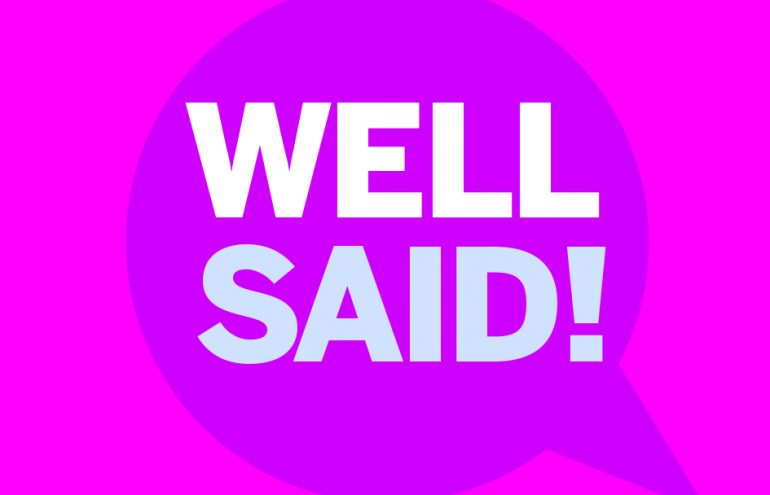We’ve all found ourselves trapped in a dead-end conversation at a networking event. Someone drones on about a topic in which you have no interest. Or, it’s simply someone you don’t like. Or maybe you just don’t want to spend that much time speaking with any one person.
You need an escape that doesn’t require you to be rude.
Random Acts of Chatter
Getting stuck in a dead-end networking conversation is often the result of aimlessly talking with anyone and everyone about almost anything, without a clear purpose in doing so. Since you don’t know what you’re trying to accomplish, you’re neither screening conversation partners nor directing the conversations. As a result, you’re guaranteeing irrelevant or indulgent chatter.
Randomness may also cause you to attend the wrong events, which are populated by too few people of the type of people you want to meet. When you go to an event simply because it’s available, you’re taking the “Fogameer Approach” — that is, speaking with anyone who can fog a mirror.
Choose Hunting over Networking
The solution? Change your approach from networking to hunting. My definitions of the terms are intentionally stark, perhaps even a bit harsh.
- Networking. You hang around any available event, without a purpose, chatting with as many people as you can, initiating “relationships,” while believing that coming home with a business card from anyone with a pulse constitutes some type of success.
- Hunting. You know with whom you want to speak, and more importantly, with whom you don’t. You have a specific profile of who would need someone with your skills and the conditions that trigger demand for those skills and expertise. You only go to events that will most likely have attendees who will match that profile. You spend your time filtering the room, briefly explaining to others the problem you solve, finding those who are experiencing that problem, and disengaging from all others as graciously as possible.
By hunting rather than networking, you will first deduce which industries have high concentrations of companies experiencing your demand-triggering problem, and then hunt out those industries based on the profile you have identified.
When you first arrive and pick up your badge, take a look at how it’s formatted. Where does the company name appear? Is it easily read from five to six feet away? If so, you can scan badges to identify the wearer’s likely industry affiliation, and then, based on your previous profile exercise, you can avoid speaking to those who are irrelevant. (In your profiling exercise, you’ll have deduced which industries have high concentrations of companies experiencing your demand-triggering problem.)
Testing the Crowd: How to Engage or Exit Graciously
Occasionally, you will get trapped. When that happens, the way to escape graciously is to first test whether or not the person acknowledges that her company is experiencing — or may soon face — your demand-triggering problem.
Initiating the profile test:
You (reading her badge): “Hello, Jane. I’m [say your name and extend your hand]. Nice to meet you.”
Jane: “Jane Newman. Nice to meet you, too.”
You (pointing to her badge): “Integrated Biometrics? I’m not familiar with your firm, but it sounds like you might be in the secure access business. How close am I?”
Jane: “Good guess. We make biometric identification devices that secure sensitive areas for hospitals and defense contractors.”
If Jane’s company matches your target profile:
You: “From what I see in the press, that’s a very dynamic business these days.”
Jane: “Oh, yes. It feels like the technology changes monthly. It borders on chaos.”
You: “Besides the pace of technical innovation, it seems like biometric security companies are also wrestling with [your demand-triggering problem]. You’re in the business. Tell me, am I on track, or way off base?”
Jane: “You’re pretty close, but [Jane modifies your understanding of the problem].”
You: “Thanks for clarifying. That makes sense. I’d love to chat with you about some ideas I have for dealing with that, but I don’t want to monopolize your attention. You’re here to network. Would it make sense for us to explore this by phone over the next week or so?”
Jane: “Sure, but this week is a bear for me.”
You: “I understand. Mine’s a bit jammed too.” (Pull out your phone.) “Want to put something on our calendars now, and confirm it tomorrow?”
Jane: “No. Too many things are fluid right now. How about if you send me an email next week with some options?”
You: “Okay. May I get your card?” (Don’t say, “Here’s my card.” By doing so, you give up control of the contact to Jane. You always want to be the initiator. You know you’ll email Jane. You don’t know that Jane will email you.)
If Jane’s company does not match your target profile but is related to it:
You (pointing to her badge): “Integrated Biometrics? I’m not familiar with your firm, but it sounds like you might be in the secure access business. How close am I?”
Jane: “Close, but not quite. We aggregate the data that those devices collect, and analyze it for activity patterns.”
You: “Interesting. Do you partner with the device companies?”
Jane: “Sure.”
You: “I’m writing an article about how [your demand-triggering problem] affects the biometric security business. Do you think any of your partners would be willing to have a brief call with me to get a quote from them?”
Jane: “I don’t see why not. They might welcome the exposure.”
You: “Would it be an imposition for me to ask you to introduce me to a few of them?”
Jane: “Not at all.”
You: “Thanks so much. I don’t want to monopolize your attention here. How about if I send you an email to arrange a time for a brief call about who might make the most sense?”
Jane: “That’s fine. Here’s my card.”
If Jane is a dead-end:
You (pointing to her badge): “Integrated Biometrics? I’m not familiar with your firm, but it sounds like you might be in the secure access business. How close am I?”
Jane: “Not close, I’m afraid. We aren’t in that business at all.”
You: “Jane, I apologize, but I’ll have to excuse myself. One of my clients is in the middle of something time-sensitive, and I can feel my phone buzzing in my pocket, so I’d better find a quiet spot. It’s nice to have met you.”
Illustration ©iStockPhoto.com























